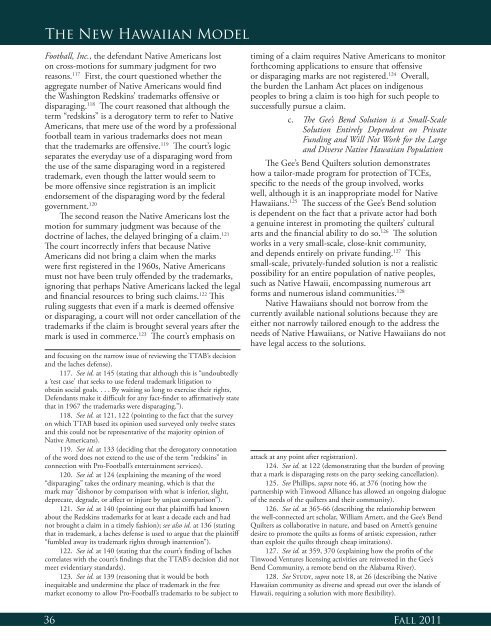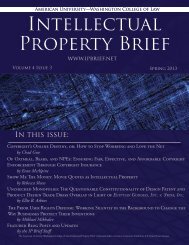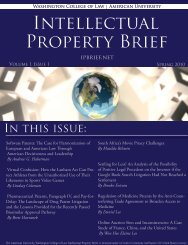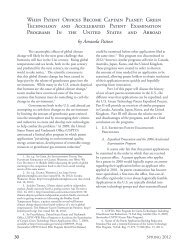The New Hawaiian Model: The Native Hawaiian Cultural Trademark ...
The New Hawaiian Model: The Native Hawaiian Cultural Trademark ...
The New Hawaiian Model: The Native Hawaiian Cultural Trademark ...
You also want an ePaper? Increase the reach of your titles
YUMPU automatically turns print PDFs into web optimized ePapers that Google loves.
<strong>The</strong> <strong>New</strong> <strong>Hawaiian</strong> <strong>Model</strong><br />
Football, Inc., the defendant <strong>Native</strong> Americans lost<br />
on cross-motions for summary judgment for two<br />
reasons. 117 First, the court questioned whether the<br />
aggregate number of <strong>Native</strong> Americans would find<br />
the Washington Redskins’ trademarks offensive or<br />
disparaging. 118 <strong>The</strong> court reasoned that although the<br />
term “redskins” is a derogatory term to refer to <strong>Native</strong><br />
Americans, that mere use of the word by a professional<br />
football team in various trademarks does not mean<br />
that the trademarks are offensive. 119 <strong>The</strong> court’s logic<br />
separates the everyday use of a disparaging word from<br />
the use of the same disparaging word in a registered<br />
trademark, even though the latter would seem to<br />
be more offensive since registration is an implicit<br />
endorsement of the disparaging word by the federal<br />
government. 120<br />
<strong>The</strong> second reason the <strong>Native</strong> Americans lost the<br />
motion for summary judgment was because of the<br />
doctrine of laches, the delayed bringing of a claim. 121<br />
<strong>The</strong> court incorrectly infers that because <strong>Native</strong><br />
Americans did not bring a claim when the marks<br />
were first registered in the 1960s, <strong>Native</strong> Americans<br />
must not have been truly offended by the trademarks,<br />
ignoring that perhaps <strong>Native</strong> Americans lacked the legal<br />
and financial resources to bring such claims. 122 This<br />
ruling suggests that even if a mark is deemed offensive<br />
or disparaging, a court will not order cancellation of the<br />
trademarks if the claim is brought several years after the<br />
mark is used in commerce. 123 <strong>The</strong> court’s emphasis on<br />
and focusing on the narrow issue of reviewing the TTAB’s decision<br />
and the laches defense).<br />
117. See id. at 145 (stating that although this is “undoubtedly<br />
a ‘test case’ that seeks to use federal trademark litigation to<br />
obtain social goals. . . . By waiting so long to exercise their rights,<br />
Defendants make it difficult for any fact-finder to affirmatively state<br />
that in 1967 the trademarks were disparaging.”).<br />
118. See id. at 121, 122 (pointing to the fact that the survey<br />
on which TTAB based its opinion used surveyed only twelve states<br />
and this could not be representative of the majority opinion of<br />
<strong>Native</strong> Americans).<br />
119. See id. at 133 (deciding that the derogatory connotation<br />
of the word does not extend to the use of the term “redskins” in<br />
connection with Pro-Football’s entertainment services).<br />
120. See id. at 124 (explaining the meaning of the word<br />
“disparaging” takes the ordinary meaning, which is that the<br />
mark may “dishonor by comparison with what is inferior, slight,<br />
deprecate, degrade, or affect or injure by unjust comparison”).<br />
121. See id. at 140 (pointing out that plaintiffs had known<br />
about the Redskins trademarks for at least a decade each and had<br />
not brought a claim in a timely fashion); see also id. at 136 (stating<br />
that in trademark, a laches defense is used to argue that the plaintiff<br />
“fumbled away its trademark rights through inattention”).<br />
122. See id. at 140 (stating that the court’s finding of laches<br />
correlates with the court’s findings that the TTAB’s decision did not<br />
meet evidentiary standards).<br />
123. See id. at 139 (reasoning that it would be both<br />
inequitable and undermine the place of trademark in the free<br />
market economy to allow Pro-Football’s trademarks to be subject to<br />
timing of a claim requires <strong>Native</strong> Americans to monitor<br />
forthcoming applications to ensure that offensive<br />
or disparaging marks are not registered. 124 Overall,<br />
the burden the Lanham Act places on indigenous<br />
peoples to bring a claim is too high for such people to<br />
successfully pursue a claim.<br />
c. <strong>The</strong> Gee’s Bend Solution is a Small-Scale<br />
Solution Entirely Dependent on Private<br />
Funding and Will Not Work for the Large<br />
and Diverse <strong>Native</strong> <strong>Hawaiian</strong> Population<br />
<strong>The</strong> Gee’s Bend Quilters solution demonstrates<br />
how a tailor-made program for protection of TCEs,<br />
specific to the needs of the group involved, works<br />
well, although it is an inappropriate model for <strong>Native</strong><br />
<strong>Hawaiian</strong>s. 125 <strong>The</strong> success of the Gee’s Bend solution<br />
is dependent on the fact that a private actor had both<br />
a genuine interest in promoting the quilters’ cultural<br />
arts and the financial ability to do so. 126 <strong>The</strong> solution<br />
works in a very small-scale, close-knit community,<br />
and depends entirely on private funding. 127 This<br />
small-scale, privately-funded solution is not a realistic<br />
possibility for an entire population of native peoples,<br />
such as <strong>Native</strong> Hawaii, encompassing numerous art<br />
forms and numerous island communities. 128<br />
<strong>Native</strong> <strong>Hawaiian</strong>s should not borrow from the<br />
currently available national solutions because they are<br />
either not narrowly tailored enough to the address the<br />
needs of <strong>Native</strong> <strong>Hawaiian</strong>s, or <strong>Native</strong> <strong>Hawaiian</strong>s do not<br />
have legal access to the solutions.<br />
attack at any point after registration).<br />
124. See id. at 122 (demonstrating that the burden of proving<br />
that a mark is disparaging rests on the party seeking cancellation).<br />
125. See Phillips, supra note 46, at 376 (noting how the<br />
partnership with Tinwood Alliance has allowed an ongoing dialogue<br />
of the needs of the quilters and their community).<br />
126. See id. at 365-66 (describing the relationship between<br />
the well-connected art scholar, William Arnett, and the Gee’s Bend<br />
Quilters as collaborative in nature, and based on Arnett’s genuine<br />
desire to promote the quilts as forms of artistic expression, rather<br />
than exploit the quilts through cheap imitations).<br />
127. See id. at 359, 370 (explaining how the profits of the<br />
Tinwood Ventures licensing activities are reinvested in the Gee’s<br />
Bend Community, a remote bend on the Alabama River).<br />
128. See Study, supra note 18, at 26 (describing the <strong>Native</strong><br />
<strong>Hawaiian</strong> community as diverse and spread out over the islands of<br />
Hawaii, requiring a solution with more flexibility).<br />
36 Fall 2011








